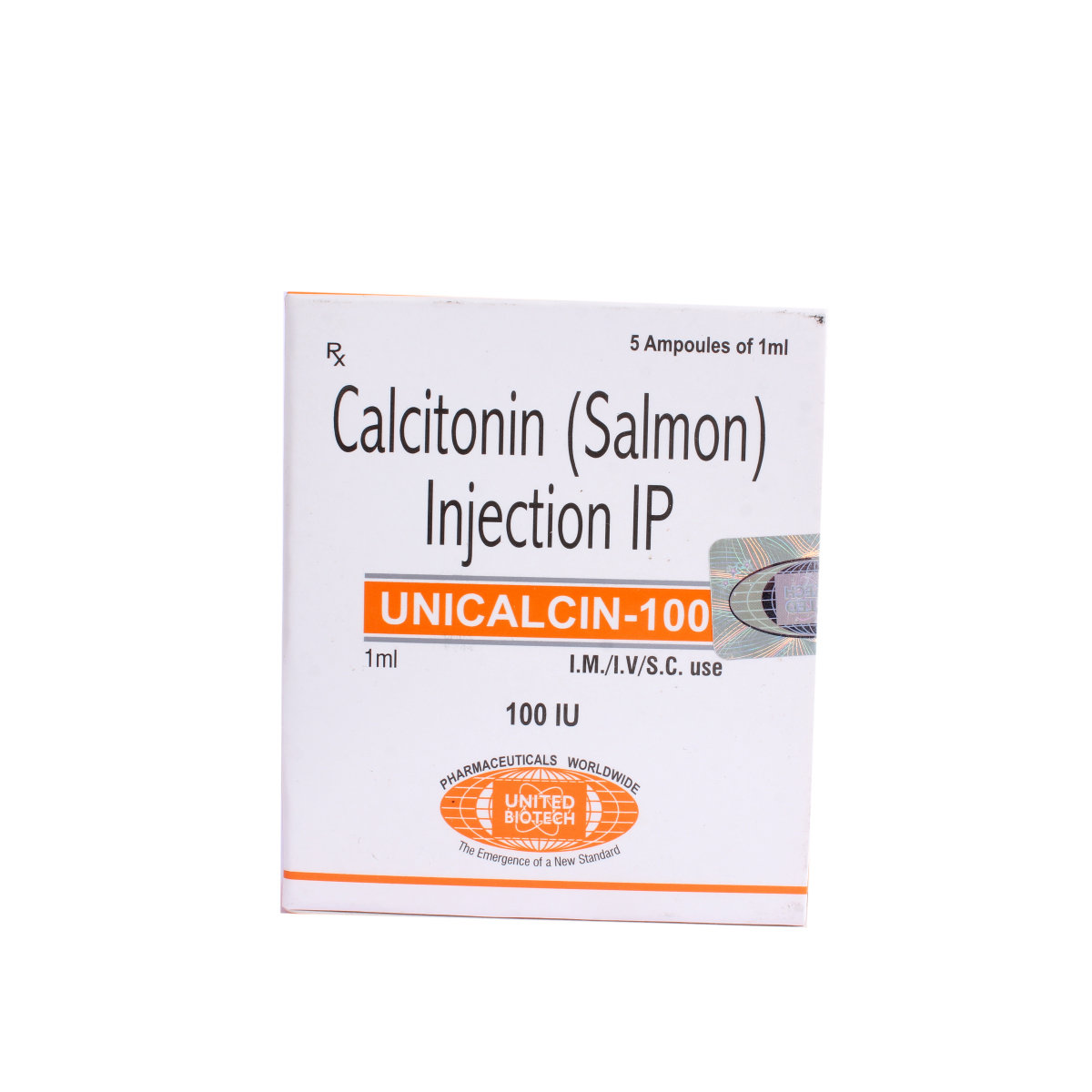Calcito-S 100IU Injection 1 ml



MRP ₹303.5
(Inclusive of all Taxes)
₹45.5 Cashback (15%)
know your delivery time
Provide Delivery Location
Composition :
Manufacturer/Marketer :
Consume Type :
Expires on or after :
Return Policy :

Secure Payment

Trusted by 8 Crore Indians

Genuine Products
Therapeutic Class
Country of origin
Manufacturer/Marketer address
Author Details
We provide you with authentic, trustworthy and relevant information
Disclaimer
Alcohol
Safe if prescribed
Consuming alcohol while on treatment with Calcito-S 100IU Injection 1 ml is not recommended since it may result in unpleasant side effects or make you more susceptible to the effects of alcohol.
Pregnancy
Consult your doctor
Calcito-S 100IU Injection 1 ml should be used in pregnancy only when the benefit to the mother outweighs the risk to the foetus. Hence, inform your doctor if you are pregnant or expecting pregnancy.
Breast Feeding
Consult your doctor
Tell your doctor if you are a nursing mother before taking Calcito-S 100IU Injection 1 ml; your doctor will decide whether Calcito-S 100IU Injection 1 ml can be taken by breastfeeding mothers.
Driving
Safe if prescribed
Calcito-S 100IU Injection 1 ml does not impact your ability to drive or operate machinery.
Liver
Consult your doctor
Inform your doctor before receiving the Calcito-S 100IU Injection 1 ml if you have a liver impairment. It should be used with caution in patients with liver conditions as it may alter liver functioning.
Kidney
Consult your doctor
Inform your doctor before receiving the Calcito-S 100IU Injection 1 ml if you have kidney impairment. Periodic examinations of urine sediment should be considered as this medicine may cause urine sediment abnormalities.
Children
Safe if prescribed
Calcito-S 100IU Injection 1 ml is not recommended for children as safety and effectiveness have not been established.
Product Substitutes
Keep Refrigerated. Do not freeze.Prepaid payment required.
About Calcito-S 100IU Injection 1 ml
Calcito-S 100IU Injection 1 ml belongs to groups of medications called hypocalcemic agents, used to treat high blood calcium levels (hypercalcemia) and Postmenopausal Osteoporosis. Besides this, it can also help treat complications of Paget's disease. Hypercalcemia is a condition in which the calcium level in your blood is above normal. Postmenopausal osteoporosis is a medical condition that causes thinning and weakening of the bones during/after a menopausal period. Paget’s disease is a chronic disease of bone that disrupts the replacement of old bone tissue with new bone tissue, resulting in the new bone that is abnormally shaped, weak and brittle.
Calcito-S 100IU Injection 1 ml contains Calcitonin. It reduces the activity of osteoclasts, which are the cells responsible for bone breakdown. When bone is broken down, the calcium in the bone is released into the bloodstream. As a result, calcitonin's suppression of osteoclasts limits the quantity of calcium released into the blood. Furthermore, it can reduce calcium resorption in the kidneys, resulting in decreased blood calcium levels.
Calcito-S 100IU Injection 1 ml will be administered by a qualified healthcare professional. Kindly do not self-administer. In some cases, Calcito-S 100IU Injection 1 ml can cause side effects, including injection site reactions, nausea with or without vomiting and flushing of the face or hands. Most of these side effects of Calcito-S 100IU Injection 1 ml do not require medical attention and gradually resolve over time. However, if these side effects persist longer, please consult your doctor.
Before taking the Calcito-S 100IU Injection 1 ml, let your doctor know about all your medical conditions, sensitivities, and all medications you are using. And also, inform your doctor if you are pregnant, planning to become pregnant, or breastfeeding. Calcito-S 100IU Injection 1 ml should not be given to children as safety and efficacy have not been established.
Uses of Calcito-S 100IU Injection 1 ml
Medicinal Benefits Mweb
Key Benefits
Calcito-S 100IU Injection 1 ml contains calcitonin, which belongs to groups of medications called hypocalcemic agents and is used to treat high blood calcium levels (hypercalcemia) and Postmenopausal Osteoporosis. On the other hand, it can also help people with Paget's disease of bone. Calcito-S 100IU Injection 1 ml reduces the activity of osteoclasts, which are the cells responsible for bone breakdown. When bone is broken down, the calcium in the bone is released into the bloodstream. As a result, calcitonin's suppression of osteoclasts limits the quantity of calcium released into the blood. Furthermore, it can reduce calcium resorption in the kidneys, decreasing blood calcium levels.
Directions for Use
Side Effects of Calcito-S 100IU Injection 1 ml
- Injection site reactions
- Nausea with or without vomiting
- Flushing of the face or hands
Drug Warnings
Before taking the Calcito-S 100IU Injection 1 ml, let your doctor know about all your medical conditions, sensitivities, and all medications you are using. And also, inform your doctor if you are pregnant, planning to become pregnant, or breastfeeding. Calcito-S 100IU Injection 1 ml should not be given to children as safety and efficacy have not been established. In rare situations, Calcito-S 100IU Injection 1 ml may cause major hypersensitivity reactions in individuals receiving Miacalcin injection, including bronchospasm, inflammation of the tongue or throat and anaphylactic shock. If you encounter any of these symptoms, contact your doctor right once.
Drug-Drug Interactions
Drug-Drug Interactions
Login/Sign Up
Etelcalcetide may decrease the calcium levels in the blood. Concomitant use with calcitonin may increase the risk of hypocalcemia, or low blood calcium.
How to manage the interaction:
Although there is an interaction, calcitonin can be taken with etelcalcetide if prescribed by the doctor. Consult the prescriber if you notice symptoms of hypocalcemia like numbness or tingling around your mouth, muscle spasms, or mental changes (irritability, depression, psychosis). Do not discontinue using any medication without contacting a doctor.
Drug-Food Interactions
Drug-Food Interactions
Login/Sign Up
Drug-Diseases Interactions
Drug-Diseases Interactions
Login/Sign Up
Calcium levels in the serum are reduced . Patients who already have hypocalcemia should use caution when administering calcium to prevent unwanted side effects. It is preferable to address hypocalcemia before beginning medication. A sufficient intake of calcium and vitamin D should be made sure during the course of treatment if calcitonin is used to promote bone mineral density, as in the case of osteoporosis
How to manage the interaction:
Calcitonin may cause hypocalcemic effects. Therefore, it should be administered cautiously to patients with preexisting hypocalcemia, since they may be particularly sensitive to these effects.
Prior to beginning medication, hypocalcemia and other abnormalities of mineral metabolism, such as vitamin D deficiency, should be corrected when calcitonin is used to treat osteoporosis. The body must have an adequate quantity of calcium and vitamin D for the necessary increase in bone mineral density to occur. When treating patients with these conditions with calcitonin salmon nasal spray, serum calcium and hypocalcemia symptoms should be kept under close observation. Throughout the course of treatment, it is important to ensure an adequate intake of calcium and vitamin D
How to manage the interaction:
In patients with mineral metabolism disorders, serum calcium and symptoms of hypocalcemia should be monitored during therapy. Appropriate intake of calcium and vitamin D should be ensured throughout the course of treatment.
Drug-Drug Interactions Checker List
- LITHIUM
- ETELCALCETIDE
- FOSCARNET
Habit Forming
Special Advise
- Certain diagnostic tests, like blood tests, measure the calcitonin level in your blood, and bone density scans are used to check bone mineral density (BMD).
- Clinical monitoring of serum electrolyte concentrations is recommended.
Diet & Lifestyle Advise
- A person should consume calcium and vitamin D in their diet as it helps make stronger bones and avoid everyday osteoporosis dangers.
- A post-menopausal woman should limit salt intake as it can pose a high risk of losing more bone minerals than other women of the same age.
- Do regular exercise like weight-bearing exercises which are important for maintaining bone health.
- Calcium is important for making bones strong. Vitamin D is equally important, which helps to ensure the absorption and retention of calcium in bones, so take food high in calcium and vitamins.
All Substitutes & Brand Comparisons
RX
UNICALCIN 100IU INJECTION 1ML
United Biotech Pvt Ltd
₹304.5
(₹274.1/ 1ml)

Have a query?




